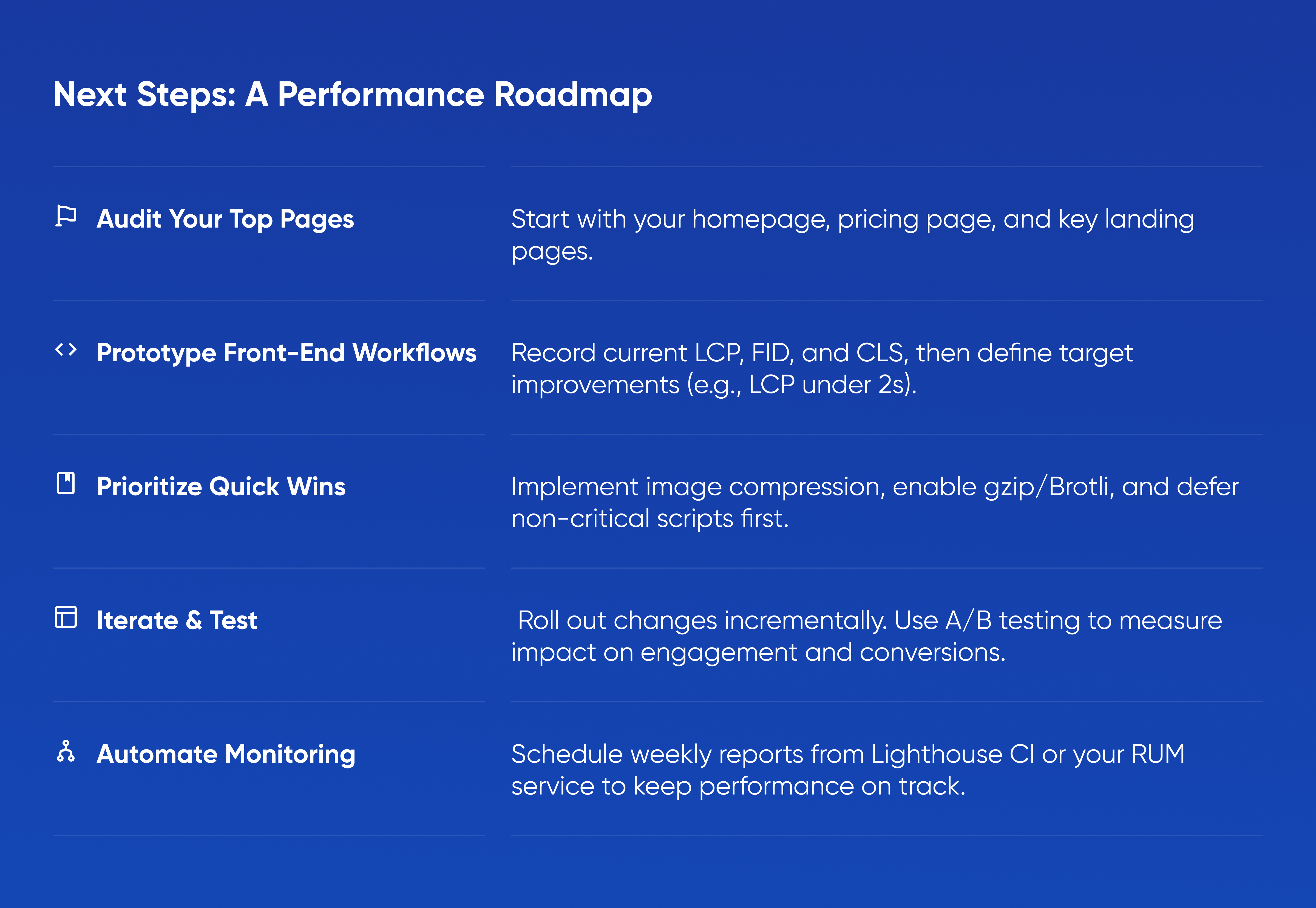In a world where users expect pages to load in under two seconds, web performance is no longer optional—it’s a competitive advantage. Slow sites frustrate visitors, drive up bounce rates, and tank your search rankings. For startups targeting product owners, founders, CTOs, and CMOs, mastering performance optimization and Google’s Core Web Vitals is essential to attract organic traffic and convert visitors into customers. In this comprehensive guide, we’ll break down the key metrics, show you hands-on tactics, and share tools to help your team ship a lightning-fast website.
Understanding Core Web Vitals
Core Web Vitals are a set of user-centered performance metrics defined by Google:
-
Largest Contentful Paint (LCP): Measures loading performance. The time it takes for the largest visible content element (image, video, text block) to render. Aim for LCP under 2.5 seconds.
-
First Input Delay (FID): Assesses interactivity. The delay between a user’s first interaction (click, tap) and the browser’s response. Target FID below 100 milliseconds.
-
Cumulative Layout Shift (CLS): Tracks visual stability. The amount of unexpected layout movement during page load—ideally under 0.1.
Google uses Core Web Vitals as ranking signals, meaning better scores can improve your SEO. More importantly, these metrics correlate strongly with user satisfaction: faster, stable pages keep people engaged and boost conversions.
Why Performance and SEO Matter for Startups
-
Higher Search Rankings: Google rewards fast, user-friendly sites. Better performance can translate into more organic visibility and traffic without extra marketing spend.
-
Lower Bounce Rates: Every 100ms of delay can reduce conversion rates by 7%. A high LCP or layout shifts that surprise users often lead them to hit “back.”
-
Improved User Trust: A smooth, responsive site feels polished and credible. This bolsters brand perception and encourages users to explore deeper.
-
Increased Conversions: Faster pages funnel users more efficiently through onboarding, sign-up, or checkout flows—critical for SaaS trials or product demos.
For lean startups with finite budgets, investing in performance is a high-ROI strategy that compounds over time.
Actionable Strategies to Boost Speed
Optimize Images and Media
-
Responsive Images: Serve appropriately sized images with srcset or use modern formats (WebP, AVIF) to reduce file size.
-
Compress Without Losing Quality: Tools like ImageOptim or Squoosh can shrink images 30-70% while preserving clarity.
-
Preload Key Images: Hint to the browser which images are critical (<link rel="preload">) for faster LCP.
Minify and Bundle Resources
-
Minify CSS/JS/HTML: Remove whitespace and comments using tools like Terser or cssnano.
-
Bundle Strategically: Combine multiple small files into a few bundles to reduce HTTP requests—but avoid giant bundles that delay parsing.
Leverage Caching and CDNs
-
Cache-Control Headers: Configure your server to set long TTLs for static assets (images, fonts, scripts) and version them via filenames.
-
Content Delivery Network: Serve assets from edge servers close to your users. Providers like Cloudflare or AWS CloudFront can cut latency dramatically.
Implement Lazy Loading
-
Images & Iframes: Use the loading="lazy" attribute or Intersection Observer API to defer off-screen content until users scroll.
-
Component-Level Code Splitting: In frameworks like React or Vue, split JavaScript bundles so non-critical code loads only when needed.
Reduce JavaScript Execution
-
Audit Third-Party Scripts: Identify and remove unused analytics or ad tags. Each external script can block the main thread.
-
Defer and Async: Load non-essential scripts with defer or async attributes to prevent render-blocking.
-
Tree Shaking: Use modern bundlers (Webpack, Rollup) to eliminate unused code from your final bundle.
Optimize Web Fonts
-
Preload Critical Fonts: Use <link rel="preload" as="font"> for your primary font files to reduce FCP delays.
-
Font Subsetting: Serve only the characters you need (e.g., for a product landing page) rather than full font libraries.
Real-World Impact and Case Study
Consider a direct-to-consumer SaaS startup that saw a 15% increase in trial sign-ups after improving their LCP from 4.2s to 2.1s. By compressing images, enabling Gzip, and deferring non-critical JavaScript, they shaved two seconds off load time. Simultaneously, organic traffic climbed 18% month-over-month as search rankings improved for their high-value keywords. These gains exemplify how performance tuning fuels both user experience and SEO.
Tools to Measure and Monitor Performance
-
Lighthouse (Chrome DevTools): Audits pages for performance, accessibility, and best practices, with detailed suggestions.
-
PageSpeed Insights: Provides field and lab data on Core Web Vitals with actionable advice.
-
WebPageTest: Offers advanced testing configurations, waterfall charts, and mobile emulation.
-
Real User Monitoring (RUM): Services like SpeedCurve or New Relic Browser capture actual user metrics for continuous monitoring.
-
Core Web Vitals Report (Google Search Console): Highlights pages that need attention across your site.
Integrate these tools into your CI/CD pipeline to catch regressions before they reach production.
Next Steps: A Performance Roadmap

By making performance optimization a continuous practice, your startup can maintain a speed advantage that fuels growth and delivers exceptional user experiences.
Ready to supercharge your site’s speed and SEO?
Movadex’s web performance experts specialize in optimizing Core Web Vitals, tuning infrastructure, and implementing best practices that keep your product fast and your users happy. Contact us today to transform your website into a high-velocity growth engine.




